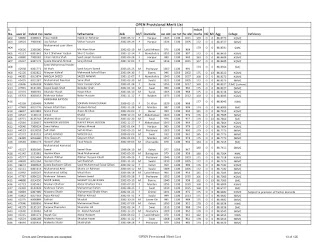Chap10 Thermodynamics MCQs with solution
Thermodynamics
|
1)
|
Heat
is the form of: a) Power b) Work c) Energy d) Motion |
C |
|
|
2)
|
Pressure
of the gas depends upon: a) Only on molecular speed b) Only on mass of molecule c) Only on number of molecules in a unit volume d) Number of molecules in a unit volume, mass and speed of molecule |
D |
|
|
3)
|
In
the isothermal process, one of the following is constant: a) Pressure b) Volume c) Temperature d) Heat energy e) Specific heat |
C |
|
|
4)
|
A
process in which no heat enters or leaves the system is called: a) Isothermal process b) Adiabatic process c) Isochoric process d) Isobaric process |
B |
|
|
5)
|
For
a gas obeying Boyle’s law, if the pressure is doubled, the volume becomes: a) Double b) One half c) Four times d) One fourth |
D |
|
|
6)
|
Gas
law PV γ = constant is for: a) Isothermal process b) Adiabatic process c) Isobaric process d) Isochoric process |
B |
|
|
7)
|
Cloud
formation in the atmosphere is example of: a) Adiabatic process b) Isothermal process c) Isochoric process d) Isobaric process |
A |
|
|
8)
|
Boyle’s
law holds for ideal gases in. a) Isochoric processes b) Isobaric processes c) Isothermal processes d) Adiabatic processes |
C |
|
|
9)
|
Which
one is true for internal energy? a) It is sum of all forms of energies associated with molecules of a system. b) It is a state function of a system c) It is proportional to transnational K.E of the molecules d) All are correct |
D |
|
|
10) |
The
internal energy of an ideal gas is directly proportional to: a) Potential energy b) Translational kinetic energy c)
Vibrational kinetic energy d) None of these |
B |
|
|
11) |
Which
one is correct relation? a) 𝐶𝑃 + 𝐶𝑉
= 𝛾 b) 𝐶𝑃 = 1 + 𝑅/𝐶𝑉 c) 𝛾 = 𝐶𝑃 /𝐶𝑉 d) 𝐶𝑃 = 1 − 𝑅/𝐶𝑉 |
C |
|
|
12) |
. Specific heats of a gas at constant pressure and at constant volume are respectively
Cp and Cv : a) Cp < Cv b) Cp > Cv c) Cp = Cv d) none of these |
B |
|
|
13) |
Numerical
value of Boltzmann’s constant is. a) 1.38 × 10−31 𝐽𝐾
−1 b) 3.18 × 10−31 𝐽𝐾 −1 c) 3.18 × 10−23 𝐽𝐾 −1 d) 1.38 × 10−23 𝐽𝐾 −1 |
D |
|
|
14) |
The
first law of thermodynamics is an expression of: a) The conservation of energy b) Conservation of mass c) Heat death of the universe d) Degradation of energy |
A |
|
|
15) |
The
amount of heat required raising the temperature of 1 kg of a substance
through 1 K is called a) Specific heat b) Heat capacity c) Calorie d) Joule |
A |
|
|
16) |
The
expression for isothermal process is: a) 𝑄 = 𝑈 b) 𝑄 = 𝑊 c) 𝑈 = 𝑊 d) 𝑈 = −𝑊 |
B |
|
|
17) |
In
adiabatic expansion, first law of thermodynamics becomes: a) ∆𝑄 = ∆𝑊 b) ∆𝑄 = ∆𝑈 c) ∆𝑊 = ∆𝑈 d)
None of these |
C |
|
|
18) |
The
Celsius scale starts from: a) 32°𝐹 b) 273 𝐾 c) 0°𝐶 d) 373 𝐾 |
C |
|
|
19) |
Unit
of thermodynamic scale of temperature
is: a) Kelvin b) Centigrade c) Fahrenheit d) Celsius |
A |
|
|
20) |
Normal
human body temperature 98.6oF corresponds to. a) 37oC b) 42 oC c) 55 oC d) 410 oC |
A |
|
|
21) |
Triple
point of water is. a) 373.16 𝐾 b) 284.16 𝐾 c)
300.16 𝐾 d) 273.16 𝐾 |
D |
|
|
22) |
If
the temperature of the sink is decreased, the efficiency of Carnot engine: a) Decreases b) Increases c) Remains the same d)
First increases and then decreases |
B |
|
|
23) |
The
area enclosed by the curve ABCDA for a Carnot heat engine represents the work done by Carnot engine. a) At any instant b) Averagely c) During its operation d) During one cycle |
D |
|
|
24) |
Carnot
cycle is: a) Reversible b) Irreversible c) Both d) None of
these |
A |
|
|
25) |
The
efficiency of diesel engine is about: a) 50% 𝑡𝑜 60% b) 25% 𝑡𝑜 30% c) 35% 𝑡𝑜 40% d) 40% 𝑡𝑜 50% |
C |
|
|
26) |
The
efficiency of petrol engine is about: a) 30% 𝑡𝑜 35% b) 25% 𝑡𝑜 30% c) 35% 𝑡𝑜 40% d) None of these |
B |
|
|
27) |
The
efficiency of a Carnot engine between HTR at T1 and LTR at T2 is given by: b) 1- c) |
C |
|
|
28) |
Working
cycle of a typical petrol engine consists of: a) Two strokes b) Four strokes c) Six strokes d) Eight
strokes |
B |
|
|
29) |
The
unit of entropy is: B)
JK B)
K/J C) J/K D)
J/K2 |
C |
|
|
30) |
Mathematically,
entropy is represented by: b)
DQ=DS/T b) DS=DQ/TQ c) DS=DQ.T d) DS=DT/Q |
B |
|
|
31) |
The
increase in the entropy means the increase in: a) Disorder b) Unavailability of energy c) Randomness d) All of these |
D |
|








Comments
Post a Comment